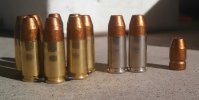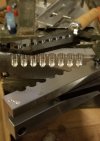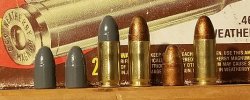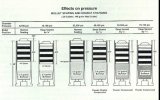You are using an out of date browser. It may not display this or other websites correctly.
You should upgrade or use an alternative browser.
You should upgrade or use an alternative browser.
HEAVY 9mm
- Thread starter Tomme boy
- Start date
CWLONGSHOT
Well-Known Member
Just when 147's are soft... and push 155....
CZ93X62
Official forum enigma
Well outside my wheelhouse. My heaviest-ever 9mm bullet weight was 147 grains, to duplicate the (EXPLETIVES DELETED) sub-sonic FBI-touted loads we got saddled with post-Miami by the Facklerites. After about a half-dozen well-hit jackrabbits with those rounds required a follow-up dispatch shot, I stopped carrying my 9mm entirely. That was c. 1989.
The 9mm was meant to use 120-125 grain bullets, and to launch them at 1200 FPS+. That was the European standard almost 120 years ago, and the addition of an expansion-capable bullet design is the only enhancement that is needed.
The 9mm was meant to use 120-125 grain bullets, and to launch them at 1200 FPS+. That was the European standard almost 120 years ago, and the addition of an expansion-capable bullet design is the only enhancement that is needed.
Last edited:
Tomme boy
Well-Known Member
The .38-200 was what I seen. If that cartridge can reach 620fps. The 9mm should be able to safely do the same at a little more pressure.
Just thinking out loud here. I have to look to see where I put the rest of the bullets I have ready to go. I don't feel like casting more right now.
Just thinking out loud here. I have to look to see where I put the rest of the bullets I have ready to go. I don't feel like casting more right now.
RicinYakima
High Steppes of Eastern Washington
Before warned, The 38/200 has over half of the bullet weight in front of the case. Will a 9 work like that?
Well I’ve been sitting here wondering what do do with some 147gr or what the mold says I have no idea the weight. Probably 152 ish with my alloy. I thought that was as heavy as you could go in a 9 mil and make it cycle. I’m staying tuned to this. I’ll be interested to see the results with this.
Joshua
Taco Aficionado/Salish Sea Pirate/Part-Time Dragon
This comes under the Teenager* heading, but pertains to heavy load development in the 9mm.
Wayyyyy back in about 1984 -1986, when oil crashed from 20-something a barrel to 14 dollars, and Alaska could not pay its bills, people were locking the front door and leaving the state. They left their dogs to roam, and since my golden-retriever/husky -half tinkerbell mix was on a 50-yard run, he and his food dish were often the target of these abandoned animals. So one day Dad comes to the basement loading room and quietly announces (low voice for effect), "I am looking for a load for my quiet gun."
Hmmmm. The WW2 - vintage MK 2 STEN, suppressed, had the recited history of employment with the British Frog Teams in the south Pacific. That was Dad's new dogcatcher, since neighbors cut the tripcord to the SPCA-approved cage trap Dad had built the year previous. Three dogs went to the pound, at a fine of $75.00 for vet and license fees to retrieve them. So, we tried humane, and the danger remained. While he was gone on business, could I work up a kitchen-door load for these mongrel animals so as not to bother the neighbors?
Using 1950s - vintage Lyman manuals, and the molds on hand, I began with #358439, cast soft to expand, and sized to .358. I recall weight at 175 grains. Since this was a 9mm load, I used charge data for that caliber. A maximum Bullseye charge of 4.8 grains was reduced by ten percent for that vital safety margin, with the seating in a belled and chamfered case to about half way up the front driving band. It all made sense to a 14-year old.*
My ears ringing, I immediately recalled somewhat stout recoil from the STEN. I also employed deliberate effort to both remove the case body from the chamber, and retrieve the head separately. That wasn't supposed to happen. At the end, I discovered 2.5 grains of Bullseye would cycle the action, or preferably 2.7 grains preset from Dad's Star reloading machine. The big issue became feeding. The vintage Pacific die used a RN seating plug, which crushed the HP on that old #358439. I only got one out of every three rounds to escape that die in shape to feed reliably from the magazine. But it was quiet.
Ten years later, Dad's Class 3 collection all went down the road.
*General disclaimer
Wayyyyy back in about 1984 -1986, when oil crashed from 20-something a barrel to 14 dollars, and Alaska could not pay its bills, people were locking the front door and leaving the state. They left their dogs to roam, and since my golden-retriever/husky -half tinkerbell mix was on a 50-yard run, he and his food dish were often the target of these abandoned animals. So one day Dad comes to the basement loading room and quietly announces (low voice for effect), "I am looking for a load for my quiet gun."
Hmmmm. The WW2 - vintage MK 2 STEN, suppressed, had the recited history of employment with the British Frog Teams in the south Pacific. That was Dad's new dogcatcher, since neighbors cut the tripcord to the SPCA-approved cage trap Dad had built the year previous. Three dogs went to the pound, at a fine of $75.00 for vet and license fees to retrieve them. So, we tried humane, and the danger remained. While he was gone on business, could I work up a kitchen-door load for these mongrel animals so as not to bother the neighbors?
Using 1950s - vintage Lyman manuals, and the molds on hand, I began with #358439, cast soft to expand, and sized to .358. I recall weight at 175 grains. Since this was a 9mm load, I used charge data for that caliber. A maximum Bullseye charge of 4.8 grains was reduced by ten percent for that vital safety margin, with the seating in a belled and chamfered case to about half way up the front driving band. It all made sense to a 14-year old.*
My ears ringing, I immediately recalled somewhat stout recoil from the STEN. I also employed deliberate effort to both remove the case body from the chamber, and retrieve the head separately. That wasn't supposed to happen. At the end, I discovered 2.5 grains of Bullseye would cycle the action, or preferably 2.7 grains preset from Dad's Star reloading machine. The big issue became feeding. The vintage Pacific die used a RN seating plug, which crushed the HP on that old #358439. I only got one out of every three rounds to escape that die in shape to feed reliably from the magazine. But it was quiet.
Ten years later, Dad's Class 3 collection all went down the road.
*General disclaimer
Last edited:
Petrol & Powder
Well-Known Member
I’m going to try to not rant.
Standard bullet weights for a cartridge became the standard, for a reason. Those standard bullet weights didn’t come about by accidental happenstance.
I am squarely with Al on my disdain for the 147 grain 9mm load. I know some people like them for various reasons but I’m not one of them. The 147-grain load was originally developed to be a sub-sonic load for suppressed weapons. That is where it belongs, IMO.
After the Miami shootout, the 147 gr 9mm load was one of many half-baked ideas to come out of that deadly fiasco. That tragic event was the result of underestimating the bad guys and generally poor tactics; not ammunition failures. But the FBI was never going to say that.
The 9mm Luger cartridge does its best work with bullets between 115 and 125 grains. It was designed from the start as a high-pressure, high-speed cartridge. When you stick a heavy bullet in that little casing, you turn it into a 38 Special. Now I love the 38 Special, but we don’t need to duplicate that concept in a self-loading pistol.
There is an American tendency to think that if a 120-grain bullet is good then a 150-grain bullet must be better……. And every time someone sticks a heavy for caliber bullet in a casing they act like they’ve discovered a new planet or a cure for cancer.
The question is – Can you create a 9mm cartridge with a 147-grain bullet? The answer is: Yes.
What do you gain from loading a 147-grain bullet in a 9mm casing? The answer is: NOT MUCH.
While it is possible to create a sub-sonic round that still has a little useful energy, you give up most of what was gained in the original design.
Standard bullet weights for a cartridge became the standard, for a reason. Those standard bullet weights didn’t come about by accidental happenstance.
I am squarely with Al on my disdain for the 147 grain 9mm load. I know some people like them for various reasons but I’m not one of them. The 147-grain load was originally developed to be a sub-sonic load for suppressed weapons. That is where it belongs, IMO.
After the Miami shootout, the 147 gr 9mm load was one of many half-baked ideas to come out of that deadly fiasco. That tragic event was the result of underestimating the bad guys and generally poor tactics; not ammunition failures. But the FBI was never going to say that.
The 9mm Luger cartridge does its best work with bullets between 115 and 125 grains. It was designed from the start as a high-pressure, high-speed cartridge. When you stick a heavy bullet in that little casing, you turn it into a 38 Special. Now I love the 38 Special, but we don’t need to duplicate that concept in a self-loading pistol.
There is an American tendency to think that if a 120-grain bullet is good then a 150-grain bullet must be better……. And every time someone sticks a heavy for caliber bullet in a casing they act like they’ve discovered a new planet or a cure for cancer.
The question is – Can you create a 9mm cartridge with a 147-grain bullet? The answer is: Yes.
What do you gain from loading a 147-grain bullet in a 9mm casing? The answer is: NOT MUCH.
While it is possible to create a sub-sonic round that still has a little useful energy, you give up most of what was gained in the original design.
@Petrol & Powder when your just banging steel out to 50 yards, and shooting suppressed just for fun the 147 seems to be the ticket, you get a little better ring on the plate and the bullet stays subsonic.
So the point is when you shoot steel your not really caring what happens with energy or penetration at that point, its just to hear the steel ring.
Now in a self defense scenario, I agree whole heartedly the 115-125 range is the way to go, Its all about intended use.
Honestly as a handloader i think there is a little tinkerer in all of us to want to explore different things, and push the envelope at times on what can be done.
So the point is when you shoot steel your not really caring what happens with energy or penetration at that point, its just to hear the steel ring.
Now in a self defense scenario, I agree whole heartedly the 115-125 range is the way to go, Its all about intended use.
Honestly as a handloader i think there is a little tinkerer in all of us to want to explore different things, and push the envelope at times on what can be done.
358156 hp
At large, whereabouts unknown.
While I favor heavier bullets for 9mm, my choices tend to run from 124 gr to the 155 Elco HP, and my favorite cast is Ranch Dogs 135 gr. Surprisingly, the Ranch Dog feeds in everything except my M&P Compact which needs a smaller meplat, and has a really tight chamber. I keep threatening to sell off the M&P because of this.
My other heavy 9mm bullet may com as a surprise to some of you. 358156 & 358156HP are dimensionally similar to Hornadys 147 gr 9mm bullet if you leave the gas check off and allow the step in the base to act as a rebated boat tail of sorts. This allows slightly deeper seating to help get a shorter overall length.
My other heavy 9mm bullet may com as a surprise to some of you. 358156 & 358156HP are dimensionally similar to Hornadys 147 gr 9mm bullet if you leave the gas check off and allow the step in the base to act as a rebated boat tail of sorts. This allows slightly deeper seating to help get a shorter overall length.
Last edited:
Intel6
Active Member
I have shot heavier (not as heavy as the OP) bullets in 9mm for pistols but I mostly use them almost exclusively in my competition revolvers chambered in 9mm and .38 Mid (shortened .38 SPL) in a .357 revolver.
I messed around with the Lee 158 RNFP bullet and I was able to get them to shoot decently in my autos. It wasn't the best due to the WFN style profile that doesn't make for great function.
I then got the NOE 155 ELCO mould and that made great bullets for both auto and revolver. These shoot great in both and the design permits me to load them longer for the revolver. In the pic you can see them (coated with Bronze 500 Hi-Tek) loaded in revolver rounds and slightly shorter for the auto.

The ELCO worked great but I was looking for a RN style bullet for better revolver reloading and ended up with a MP Moulds 8 cavity mould that makes a slick sided (for coating) 157-160 gr RN bullet which has become my main bullet for the revolvers. This is my first 8 cavity and boy does it crank out the bullets. The slick bullets come out of the mould so easily and you have 8 bullets every cast. In the second pic you can see the bullets and them loaded in the case. I was messing with PC also so the left ones are PC'd and the ones on the right are Hi-Tek. I have shot this bullet in autos, the loaded round on the right has a slightly shorter OAL.


I messed around with the Lee 158 RNFP bullet and I was able to get them to shoot decently in my autos. It wasn't the best due to the WFN style profile that doesn't make for great function.
I then got the NOE 155 ELCO mould and that made great bullets for both auto and revolver. These shoot great in both and the design permits me to load them longer for the revolver. In the pic you can see them (coated with Bronze 500 Hi-Tek) loaded in revolver rounds and slightly shorter for the auto.

The ELCO worked great but I was looking for a RN style bullet for better revolver reloading and ended up with a MP Moulds 8 cavity mould that makes a slick sided (for coating) 157-160 gr RN bullet which has become my main bullet for the revolvers. This is my first 8 cavity and boy does it crank out the bullets. The slick bullets come out of the mould so easily and you have 8 bullets every cast. In the second pic you can see the bullets and them loaded in the case. I was messing with PC also so the left ones are PC'd and the ones on the right are Hi-Tek. I have shot this bullet in autos, the loaded round on the right has a slightly shorter OAL.



